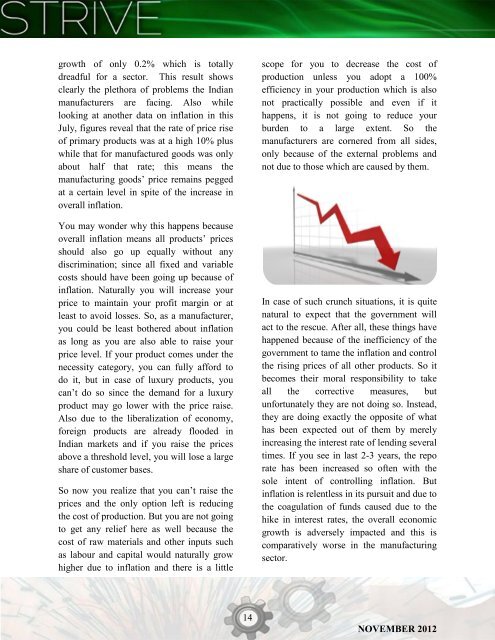sTRIVE final.pdf
You also want an ePaper? Increase the reach of your titles
YUMPU automatically turns print PDFs into web optimized ePapers that Google loves.
growth of only 0.2% which is totally<br />
dreadful for a sector. This result shows<br />
clearly the plethora of problems the Indian<br />
manufacturers are facing. Also while<br />
looking at another data on inflation in this<br />
July, figures reveal that the rate of price rise<br />
of primary products was at a high 10% plus<br />
while that for manufactured goods was only<br />
about half that rate; this means the<br />
manufacturing goods’ price remains pegged<br />
at a certain level in spite of the increase in<br />
overall inflation.<br />
You may wonder why this happens because<br />
overall inflation means all products’ prices<br />
should also go up equally without any<br />
discrimination; since all fixed and variable<br />
costs should have been going up because of<br />
inflation. Naturally you will increase your<br />
price to maintain your profit margin or at<br />
least to avoid losses. So, as a manufacturer,<br />
you could be least bothered about inflation<br />
as long as you are also able to raise your<br />
price level. If your product comes under the<br />
necessity category, you can fully afford to<br />
do it, but in case of luxury products, you<br />
can’t do so since the demand for a luxury<br />
product may go lower with the price raise.<br />
Also due to the liberalization of economy,<br />
foreign products are already flooded in<br />
Indian markets and if you raise the prices<br />
above a threshold level, you will lose a large<br />
share of customer bases.<br />
So now you realize that you can’t raise the<br />
prices and the only option left is reducing<br />
the cost of production. But you are not going<br />
to get any relief here as well because the<br />
cost of raw materials and other inputs such<br />
as labour and capital would naturally grow<br />
higher due to inflation and there is a little<br />
scope for you to decrease the cost of<br />
production unless you adopt a 100%<br />
efficiency in your production which is also<br />
not practically possible and even if it<br />
happens, it is not going to reduce your<br />
burden to a large extent. So the<br />
manufacturers are cornered from all sides,<br />
only because of the external problems and<br />
not due to those which are caused by them.<br />
In case of such crunch situations, it is quite<br />
natural to expect that the government will<br />
act to the rescue. After all, these things have<br />
happened because of the inefficiency of the<br />
government to tame the inflation and control<br />
the rising prices of all other products. So it<br />
becomes their moral responsibility to take<br />
all the corrective measures, but<br />
unfortunately they are not doing so. Instead,<br />
they are doing exactly the opposite of what<br />
has been expected out of them by merely<br />
increasing the interest rate of lending several<br />
times. If you see in last 2-3 years, the repo<br />
rate has been increased so often with the<br />
sole intent of controlling inflation. But<br />
inflation is relentless in its pursuit and due to<br />
the coagulation of funds caused due to the<br />
hike in interest rates, the overall economic<br />
growth is adversely impacted and this is<br />
comparatively worse in the manufacturing<br />
sector.<br />
14<br />
NOVEMBER 2012







